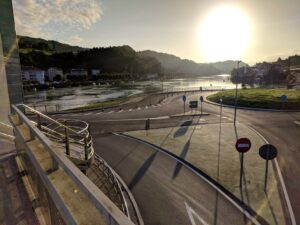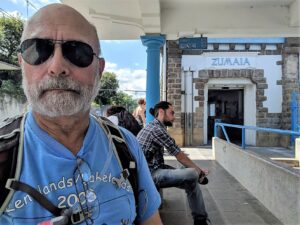My Camino Day 8/18 2018
My Camino Day 8/18 2018 was my last day on el Camino in 2018 and, in retrospect, may have taught me my biggest Camino lesson. It echoes through the years to as I write this post in April, 2023.
I did not understand that lesson – that my spirit had been captured by the Camino, that I had become a true member of the Camino community, a peregrino – at the time. What had started out as an adventure, a response to curiosity, had become something far more, a pilgrimage. Wikipedia says that “A pilgrimage is a journey, often into an unknown or foreign place, where a person goes in search of new or expanded meaning about their self, others, nature, or a higher good through the experience. It can lead to a personal transformation, after which the pilgrim returns to their daily life.”
It is now clear that those four days in 2018 transformed an elderly atheist into a pilgrim in search of something about himself and his life. While the religious aspects of this are unknowable for me, the journey itself became enormously important somewhere between Irún and Zumaia.
The Beginning
 The day began gloriously as I crossed Itsasadarra Urumea, that part of the Urumea river that is strongly affected by the tides of the Bay of Biscay, on my way to the train station to return to Orio. Crossing the Urumea was a necessary first step because the terminal for the part of the local light rail system that goes to Orio is on the West side of the river, while the station for the part that goes to Irún is on the East side. I was sufficiently aware of this in 2018 to go to the correct station. Three years later, in 2021, … but that’s a story for a different “My Camino Day,” one that has not yet been written.
The day began gloriously as I crossed Itsasadarra Urumea, that part of the Urumea river that is strongly affected by the tides of the Bay of Biscay, on my way to the train station to return to Orio. Crossing the Urumea was a necessary first step because the terminal for the part of the local light rail system that goes to Orio is on the West side of the river, while the station for the part that goes to Irún is on the East side. I was sufficiently aware of this in 2018 to go to the correct station. Three years later, in 2021, … but that’s a story for a different “My Camino Day,” one that has not yet been written.
 The train was waiting at the station and, just a short while later, I found myself back at the Orio station where I had ended my day on August 11th. It was, indeed, a beautiful morning with the sun rising over the hills and the Orioko Itsasadarra to the east of the Orio light rail train station.
The train was waiting at the station and, just a short while later, I found myself back at the Orio station where I had ended my day on August 11th. It was, indeed, a beautiful morning with the sun rising over the hills and the Orioko Itsasadarra to the east of the Orio light rail train station.
Memory plays tricks, but mine is clear that it was long after my three weeks as a student in the Lacunza School‘s Spanish Immersion program 2018 that I became comfortable with the dual languages of el Pais Vasco, the Basque Country, of Northern Spain. The basque, or euskara, word “itsasadarra,” which translates as “estuary” or “tidal river” seems normal, if extremely difficult to pronounce, today; such euskara words were very, very strange in 2018.
 The hike leaving Orio is along a two-lane road and attracts walkers and joggers as well as peregrinos. The path itself is very flat until a left turn takes it up a hill according to Gronze.com. I was expecting that turn and that climb as I walked along next to the placid estuary and am sure, in retrospect, that there were two yellow arrows at some point, one of which showed that I had a choice of continuing along the Orioko, the other leading me to the small climb over the hill.
The hike leaving Orio is along a two-lane road and attracts walkers and joggers as well as peregrinos. The path itself is very flat until a left turn takes it up a hill according to Gronze.com. I was expecting that turn and that climb as I walked along next to the placid estuary and am sure, in retrospect, that there were two yellow arrows at some point, one of which showed that I had a choice of continuing along the Orioko, the other leading me to the small climb over the hill.
 Or, maybe, I just missed an arrow.
Or, maybe, I just missed an arrow.
I also know now what I did not know then: An absolute Camino route does not really exist; in fact, the marked route is continuously changing to accommodate everything from avoiding problem areas to routing peregrinos next to businesses that offer food, drink, and shelter. And more. My mind also harbors a suspicion that, at least in el Pais Vasco, The Way can be defined by anyone with a can of yellow spray paint. There are a LOT of yellow arrows there, sometimes pointing in very different directions.
I am convinced that none of this is particularly important. I have been lost with others, another story not yet told, and been lost alone. Simply continuing on and asking for directions when it seems necessary has led to everything working out sooner or later, at least so far. This mindset may not be the best one for other peregrinos, and would be terrible for those focused on arriving at the Santiago de Compostela Cathedral, but it has worked well for me as one for whom el Camino is about the journey rather than the destination.
The Middle
Memory plays tricks, but my memory is clear that a I began to recognize something in myself somewhere along The Path during the morning of the 18th. My steps slowed as something I could not define came into conflict with my “mission oriented” nature. The slowdown was not intentional, but it became clear as the morning wore on.
My time in that little cafeteria gave me an important clue: My goal was not to “get somewhere,” be it Zumaia or Santiago. So, what was it?
As I reflected on that question, I knew that I wanted my journey, my Camino, to continue. El Camino de Santiago del Norte had, in some way, become a part of me and I had, in the tiniest of ways, become a part of it.
I would be back.
The End
 Memory plays tricks. My memory resists all attempts to recall my arrival in Zumaia. The train station is to the east of most of the town. I believe that I saw little of the town itself as memory says that the Camino passed the train station before going into town. In any event, I failed to take any useful pictures between the boats at low tide and the train station. I looked at the information available: what I knew of the Camino route; the next train station along the line; the time of day; and the train schedule. All that information convinced me that, no matter what my spirit demanded, continuing my hike that day was not a good idea.
Memory plays tricks. My memory resists all attempts to recall my arrival in Zumaia. The train station is to the east of most of the town. I believe that I saw little of the town itself as memory says that the Camino passed the train station before going into town. In any event, I failed to take any useful pictures between the boats at low tide and the train station. I looked at the information available: what I knew of the Camino route; the next train station along the line; the time of day; and the train schedule. All that information convinced me that, no matter what my spirit demanded, continuing my hike that day was not a good idea.
I entered the train station and waited for the train that would return me to the station where I had begun my day by stepping on to a train that would take me to Orio. In August of 2021, I would return to that train station and begin the second part of my journey.
But that is another story about another My Camino Day.
